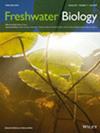浮游植物群落在富营养化梯度上的稳定性:来自年度和月度时间尺度的见解
IF 2.8
2区 生物学
Q2 ECOLOGY
引用次数: 0
摘要
探讨自然群落稳定性对富营养化等人为环境变化的响应是当前生态学研究的一个重要课题。富营养化直接影响浮游植物群落的物种动态、丰度和演替,可能导致这些群落多年来生态过程的变化。然而,浮游植物群落的年和月动态如何沿着富营养化梯度变化以保持稳定尚不清楚。我们对一个大型浅湖进行了为期8年的调查,整个湖泊呈现富营养化梯度。利用该数据集分析了浮游植物群落的生物量稳定性(BS)、组成稳定性(CS)和物种等级-丰度曲线变化(Curve_change)三个动态特征。对这些变量进行了年度(2014年至2021年,在每个采样点收集年度数据)和月度(同期延长至96个月,每月数据)尺度的分析,以检查它们如何响应富营养化梯度而变化。富营养化梯度对年和月生物量的影响较小,但对月组成稳定性和物种等级-丰度曲线的变化影响较大。BS与CS呈正相关,与物种等级-丰度曲线变化呈负相关。这表明浮游植物可以在较短的时间尺度上通过特定的群落结构调整来维持BS,在富营养化梯度上具有不同的机制。在高营养浓度下,这种稳定性与非优势物种相对丰度的变化有关,这可以缓冲优势物种丰度的波动,并确保功能冗余。相比之下,在相对较低的营养浓度下,BS是通过优势物种之间的补偿动力学实现的,其中一个物种的减少被具有相似生态功能的另一个物种的增加所抵消。然而,这种内部调节机制在较长的时间尺度上不太明显。这些发现突出了研究富营养化对浮游植物群落稳定性影响的时间尺度的重要性,为评估和预测湖泊生态系统对未来环境变化的响应提供了重要线索。本文章由计算机程序翻译,如有差异,请以英文原文为准。
Phytoplankton Community Stability Across Eutrophic Gradients: Insights From Annual and Monthly Timescales
- Exploring the response of natural community stability to anthropogenic environmental changes, such as eutrophication, is an important topic in current ecological research. Eutrophication directly affects species dynamics, abundance and succession in phytoplankton communities, potentially leading to shifts in ecological processes in these communities over multiple years. However, it remains unclear how the annual and monthly dynamics of phytoplankton communities shift along eutrophication gradients to maintain stability.
- We conducted an 8-year survey in a large shallow lake, where the entire area exhibited a gradient of eutrophication. Using this dataset, we analysed three dynamic characteristics of phytoplankton communities: biomass stability (BS), composition stability (CS) and species rank-abundance curve change (Curve_change). These variables were analysed at annual (from 2014 to 2021, with annual data collected at each sampling site) and monthly (extending to 96 months within the same period, with monthly data) scales to examine how they changed in response to the eutrophication gradient.
- Annual and monthly BS was only slightly affected by the eutrophication gradient, whereas monthly composition stability and changes in species rank-abundance curves were significantly altered. BS correlated positively with CS but negatively with changes in the species rank-abundance curve.
- This indicates that phytoplankton can maintain BS through specific adjustments in community structure over shorter timescales, with distinct mechanisms operating across the eutrophication gradient. At high nutrient concentrations, this stability is associated with shifts in the relative abundance of non-dominant species, which buffer fluctuations in dominant species abundances and ensure functional redundancy. In contrast, at relatively low-nutrient concentrations, BS is achieved through compensatory dynamics among dominant species, where declines in one species are offset by increases in another with similar ecological functions. However, this internal regulatory mechanism is less evident over longer timescales.
- These findings highlight the importance of timescales in studying the impact of eutrophication on phytoplankton community stability, providing important clues for assessing and predicting the response of lake ecosystems to future environmental changes.
求助全文
通过发布文献求助,成功后即可免费获取论文全文。
去求助
来源期刊

Freshwater Biology
生物-海洋与淡水生物学
CiteScore
5.90
自引率
3.70%
发文量
162
审稿时长
2 months
期刊介绍:
Freshwater Biology publishes papers on all aspects of the ecology of inland waters, including rivers and lakes, ground waters, flood plains and other freshwater wetlands. We include studies of micro-organisms, algae, macrophytes, invertebrates, fish and other vertebrates, as well as those concerning whole systems and related physical and chemical aspects of the environment, provided that they have clear biological relevance.
Studies may focus at any level in the ecological hierarchy from physiological ecology and animal behaviour, through population dynamics and evolutionary genetics, to community interactions, biogeography and ecosystem functioning. They may also be at any scale: from microhabitat to landscape, and continental to global. Preference is given to research, whether meta-analytical, experimental, theoretical or descriptive, highlighting causal (ecological) mechanisms from which clearly stated hypotheses are derived. Manuscripts with an experimental or conceptual flavour are particularly welcome, as are those or which integrate laboratory and field work, and studies from less well researched areas of the world. Priority is given to submissions that are likely to interest a wide range of readers.
We encourage submission of papers well grounded in ecological theory that deal with issues related to the conservation and management of inland waters. Papers interpreting fundamental research in a way that makes clear its applied, strategic or socio-economic relevance are also welcome.
Review articles (FRESHWATER BIOLOGY REVIEWS) and discussion papers (OPINION) are also invited: these enable authors to publish high-quality material outside the constraints of standard research papers.
 求助内容:
求助内容: 应助结果提醒方式:
应助结果提醒方式:


